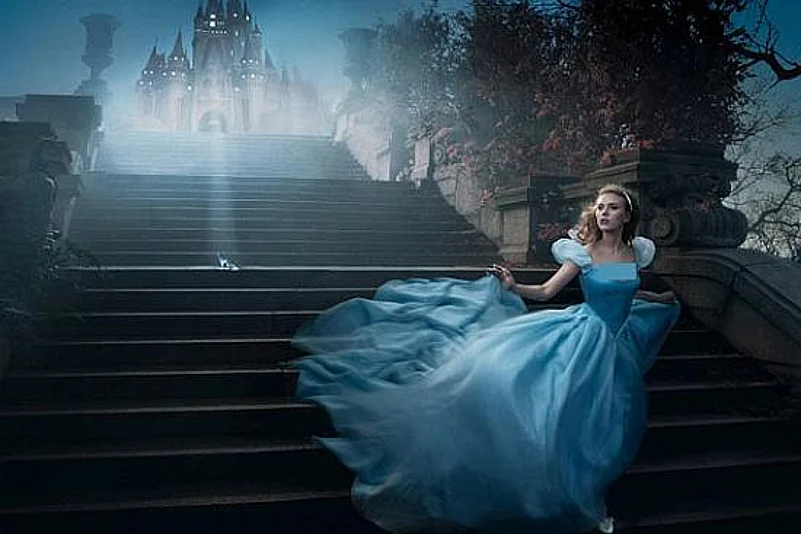I've just watched the new Disney live-action princess movie, Cinderella. State-of-the-art CGI, the fabulously feisty Helena Bonham Carter (Fairy Godmother), and the stunning Cate Blanchett (evil stepmother) combine to bring the magic of the beloved story to larger-than-life. I walked in expecting several ingenious plot twists to accommodate a politically-correct feminist narrative in the new Disney tradition of Brave and Frozen; there were none. The film stayed refreshingly true to the original story. And it charmed the socks off the (largely female and juvenile) audience.
But that isn't supposed to happen, is it? Ever since Jakob and Wilhelm Grimm began collecting and publishing folktales from the German countryside some 200 years ago, fairy tales have come under so much flak that it is a wonder they have even survived, let alone thrived.
Advertisement
First, even though the folktales (they became 'fairy tales' only when they were published in English many years later) were targeted at adults, people objected to the high levels of violence and sex in them (in the original Snow White, it is her mother, not her stepmother, who orders the huntsman to kill her daughter and bring her liver back for her to eat (wait, what?); the uncensored Rapunzel has her giving the prince away by drawing the witch's attention to her dress, which has inexplicably grown tight around the waist (and you thought the prince and Rapunzel did nothing more than chat during their nightly assignations), which was a bit rich coming from people who had burnt 'witches' at the stake until 1735, and doubtless fathered several illegitimate children themselves, but there you go.
Advertisement
Hitler added his two pfennigs to the mix by urging every German child to read the Grimm tales (the sanitised, for-kids version, i.e.) since the characters in them exhibited 'sound racial instincts', otherwise known as anti-semitism. Years later, students of Jung and Freud saw (what else but) shades of female sexual awakening (which begins with fear and disgust and ends in joyful ecstasy) in the transformation of the Beast to the handsome prince, and the struggle of the adolescent female to break free from a loving but controlling mother in the stepmother-stepdaughter conflicts.
In the seventies, American feminists burnt the books (metaphorically speaking) along with their bras (non-metaphorically speaking), after their research uncovered a patriarchal conspiracy roiling beneath the stories' flat plotlines. Women everywhere bought into this interpretation — yet another stick to bash the men with! — and a rash of revisionist princess stories appeared. Go, sistahs!
Here's the thing, though. Fairy tales, and especially princess fairy tales, have endured. The latest Cinderella became Disney's largest 2D PG-rated opening of all time, snagging a 7.2/10 average rating on Rotten Tomatoes. So what's going on? Are the women in the audience completely missing the subtext? Or is it that we've been looking at fairy tales all wrong, and the bad rap the stories get in the sexism department is somewhat undeserved? There are some very good reasons to favour the latter argument. For instance:
- From the very titles of the more popular princess stories — Cinderella, Snow White, Sleeping Beauty, Beauty and the Beast, Rapunzel — it is clear that they feature girls in lead roles. How many Bollywood or Hollywood movies can claim to do that? In fact, making a Princess movie seems to be the shortest route to casting a female lead.
- Any men that feature in the stories would not even qualify for a 'Best Supporting' award, so completely marginal are they to the story. Also, most have to work to win the heroine's favour — the Beast has to become less of a boor; Cinderella's prince uses up unconscionable amounts of taxpayer dollars in canvassing the length and breadth of the kingdom with a glass slipper; Rapunzel's prince gets a serious workout each night (climbing the tower, of course — what were you thinking?); the seven dwarves, as asexual and non-threatening as eunuchs at a Mughal zenana, make it their mission to protect and honour Snow White, even after she's dead. Guess who's wearing the pants in those relationships!
- Almost every other important character in the princess tales is also female! If stepmothers, stepsisters, witches, and evil queens make up the count for the villains, fairy godmothers and standard-issue good fairies are part of the nurturing and supportive sisterhood that tips the scales towards the happily-ever-after. Evil (male) wizards, wicked (male) genies, Batman, Santa Claus — erm, who?
- It gets better. Many princess stories, again unlike most Bollywood and Hollywood movies, pass the Bechdel Test (Is there more than one female character in the story? Do the female characters talk about anything besides a man?). Grimm women are concerned less with men and more with other feminine preoccupations — housework, food, clothes, balls, revenge, sacrifice, spindles, apples, romance, hair-combing, and, alas, who's the fairest of them all. Replace spindle with workplace, balls with Girls-Night-Outs, apples with chia seeds, and who's the fairest with Facebook dps and you have a portrait of the fairytale princess as liberated millennial woman.
- So fairytale princesses give independent womankind a bad name by sitting around waiting to be rescued? I'd like to see you climb down a tower all by yourself. With no rope, no rappelling lessons, and no smartphone. In fact, I'd like to see you do anything at all without a smartphone. Ha! Not being quite so judgmental now, are we?
Advertisement
What do you think? Is this oversimplifying, glossing over, reaching? Maybe. A little. But nothing like challenging the stereotypes about stereotypes to shake things up a little, wot?




















